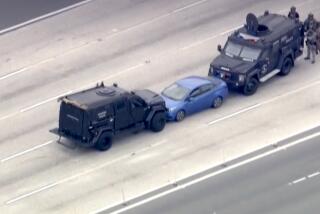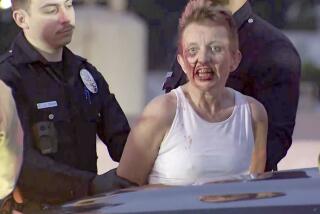20 years ago today: O.J. Simpson’s slow-speed chase stopped L.A.
- Share via
Twenty years ago today, Los Angeles came to a halt.
On June 17, 1994, television networks and cable news channels aired two hours of nonstop coverage of perhaps the most famous car chase to have ever taken place on Los Angeles freeways: O.J. Simpson in a white Ford Bronco.
As more than a dozen California Highway Patrol units and Los Angeles police squad cars tailed the Bronco, onlookers cheered and waved from overpasses and ramps during the slow-speed chase -- some even pulled over and got out of their vehicles to wave from the roadside.
It was, as one entertainment lawyer put it, “the day Los Angeles stopped.”
It all unfolded shortly after Simpson was charged with killing his ex-wife Nicole Brown Simpson and her friend Ronald Goldman.
Al Cowlings -- a longtime friend and former teammate at USC and with the Buffalo Bills -- drove the Bronco as Simpson hid in the rear, taking the chase that played out mostly on the 405 Freeway into the history books.
The dramatic arrest, broadcast live on national television, came shortly before 9 p.m., about 10 hours after he was to have turned himself in to Los Angeles police. Simpson’s lawyer, Robert L. Shapiro, said the 46-year-old football and rising acting star had agreed to surrender but bolted at the last minute with Cowlings.
The chase ended at Simpson’s mansion, where for nearly an hour more, he sat inside the Bronco, demanding to speak to his mother. Meanwhile, hundreds of supporters gathered in the upscale neighborhood, chanting “Free O.J.,” and rocking police cars. LAPD Special Weapons and Tactics team and negotiators surrounded the house, eventually coaxing Simpson out of the vehicle by cellphone.
After spending a brief moment inside the house to use the bathroom, call his mother and drink a glass of juice, Simpson was transported by police motorcade to Parker Center for booking and transported to Men’s Central Jail. Cowlings was booked on suspicion of harboring a fugitive.
Of course, the spectacle didn’t end there, as the nation would once again become transfixed by broadcasts of the courtroom drama.
The ensuing legal pratfalls the Simpson case exposed helped modernize the criminal justice infrastructure of Los Angeles County and offered some pointed lessons for prosecutors, police, criminalists and judges. As former Dist. Atty. Steve Cooley put it, it became a case study for how to handle high-profile cases.
And in terms of the now-ubiquitous live television coverage police pursuits demand, the Bronco chase remains one for the record books, even two decades later.
For news as it happens in California, follow @JasonBretWells.
More to Read
Sign up for Essential California
The most important California stories and recommendations in your inbox every morning.
You may occasionally receive promotional content from the Los Angeles Times.














